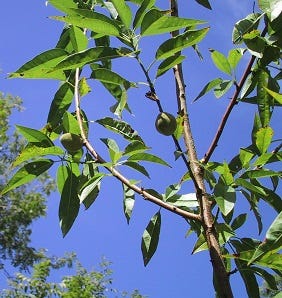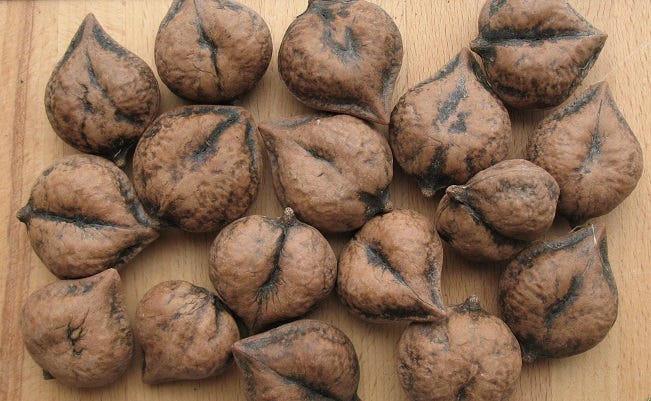As we start 2025, rather than look back at yet another year of climate chaos, I want to look forward and think about how we can adapt our growing systems to these kinds of unprecedented swings in our weather.
Forest Gardens / Food Forests are overall more inherently resistant to extremes of weather due to their diversity in structure and species [No, I don’t have scientific proof of this, but it’s pretty darn obvious] than most growing systems based on a monocultural mindset.
But can we design in more adaptive features for the future?
Instability heading our way
Readers of this blog will need little reminding of the climate change challenges we are already facing but in terms of plants and growing systems there are issues to address now and into the future:
More summer droughts
Need drought resistant plants especially on well drained soils
May need more irrigation and water storage
Designers and growers need data on drought tolerant plants and rootstocks
Make soils more resilient by increasing organic matter levels using organic mulches, chop-and-drop etc.
Almonds are more drought tolerant on almond rootstocks
More spells of intense heavy rain (especially in winter in Western Europe)
Need good drainage as few plants of use to us can grow in very wet soils. Designers and growers need data of plants tolerant of temporary waterlogging
Improving drainage can also increase drought stress though.
Make soils more resilient by increasing organic matter levels.
Walnuts are tolerant of temporary waterlogging
More higher-intensity storms
Windbreaks need designing better, thicker, denser
More data about the windfirmness of windbreak species would be useful
Warmer growing seasons
An opportunity to grow new crops (just this week The Guardian had a piece by the RHS on how almonds and figs are thriving in England)
An opportunity to change varieties of existing crops that need a longer growing season.
Persimmons are doing well in England
Falling winter hours of cold / chill
May need to change varieties to lower-chill
May need to change species entirely if they don’t get chill they need
More data on chilling requirements on different varieties would be useful
Ideological and practical requirements to grow more of our own food due to societal breakdown
Replacement of staples a particular challenge in Food forests. Do we all just eat lots of nuts?
Heartnuts - an excellent part of a nut-based diet
A strategy to maximise diversity will also mean accepting that not all crops do well every year
By maximising diversity we are not necessarily maximising yield.
This may have implications on how FFs fit into the current unsustainable economic system.
We might to accept that with respect to our growing systems we will have to go through many of the same stages as with grief (not sure if Kubler-Ross intended her work to be applied to plants!):
denial that climate change is damaging our systems
anger that this is happening because of human inability to live in harmony with nature
bargaining (“if only I’d taken more care of that tree….”)
depression when you see favourite plants fail
and acceptance that some plants will inevitably fail, but that we can design our systems to survive and thrive overall (hopefully).
Within a few decades there are even larger issues to confront:
In Western Europe, failure of AMOC (Atlantic meridional overturning circulation later this century may lead to a steady cooling of 3-7 C in Europe which could lead to cold hardiness and season length issues. In Britain a 3 or 4 C drop that would be like the climate of northern Scotland transferring to Southern England. So far any reduction in AMOC has been outweighed by global heating; this may continue or not ….
The risk of fast changes in climate due to earth system tipping points being passed will increase steadily over the next decades. If this happens then there could be rapid increase in temperatures which will cause agricultural chaos.
How do we address these conflicting uncertainties? It seems to me that we cannot address these last two points as there are so many unknowns. But if we can address the earlier ones that should put us in a good place whatever happens.








Awesome. Thanks for writing about this stuff. I started planting trees on a fairly grand scale 35 years ago in Humboldt county far northern California. I moved here thinking a lot about the climate having worked several years for Greenpeace in USA and Canada in the 80s. I saw some big chunks of old growth redwood forests from the air and they just looked black, whilst everywhere else next to them, the forest looked like mange on a dog, not very thick, you could see the ground, etc... yes it's true on a hot day here that the temperature might drop MORE THAN 10° Fahrenheit when you enter one of the little patches along the roadside that managed to survive the logging. Just apply that to the whole planet and it's easy to see that it's not global warming, it's local logging, happening everywhere, all at once, with devastating modern technology like chainsaws and fellerbunchers, PLUS the effect of cumulative impacts of logging... So protecting the ancient forests is very important, and managing all forests to become old growth ASAP, and planting trees. I planted coniferous trees around here every winter by the thousands and tens of thousands so I'm way up in the hundreds of thousands or millions by now. Luckily I also planted over 1000 diverse fruit and nut trees which survived on the Avenue of the Giants perhaps the world's best farmland, and those are doing rather well some decades on... It's like a real Garden of Eatin with multiple football fields of row crops between and around the fruit trees. It would be good if this style of agriculture would be applied to more vast acreage. Certainly logging and ranching have been making deserts for thousands of years. The entire American West is being scorched by the unchecked logging of the Pacific Northwest and northern California. It's worse than ever in my view, despite the greenwashing. They're mowing the forest like a lawn on short rotations for little pecker poles.
Shocking to hear that California, which we think of as Progressive on environmental matters, is allowing this logging to continue